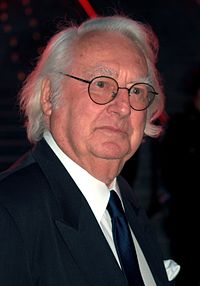From Wikipedia, the free encyclopedia
| Richard Meier | |
 Richard Meier in New York City, April 2009. | |
| Personal information | |
|---|---|
| Nationality | American |
| Born | October 12, 1934 |
| Newark, New Jersey | |
| Work | |
| Practice | Richard Meier & Partners |
| Buildings | Barcelona Museum of Contemporary Art City Hall and Central Library, The Hague Getty Center, Los Angeles |
| Awards | Pritzker Prize (1984) |
- For the American urban planner, see Richard L. Meier
Contents[hide] |
[edit] Biography
Meier was born in Newark, New Jersey.[1] He earned a Bachelor of Architecture degree from Cornell University in 1957, worked for Skidmore, Owings and Merrill briefly in 1959, and then for Marcel Breuer for three years, prior to starting his own practice in New York in 1963. Identified as one of The New York Five in 1972, his commission of the Getty Center in Los Angeles, California catapulted his popularity among the mainstream. Richard Meier & Partners Architects has offices in New York and Los Angeles with current projects ranging from China and Tel Aviv to Paris and Hamburg.Much of Meier's work builds on the work of architects of the early to mid-20th century, especially that of Le Corbusier and, in particular, Le Corbusier's early phase. Meier has built more using Corbusier's ideas than anyone, including Le Corbusier himself[citation needed]. Meier expanded many ideas evident in Le Corbusier's work, particularly the Villa Savoye and the Swiss Pavilion.
His work also reflects the influences of other designers such as Mies Van der Rohe and, in some instances, Frank Lloyd Wright and Luis Barragán (without the colour)[citation needed]. White has been used in many architectural landmark buildings throughout history, including cathedrals and the white-washed villages of the Mediterranean region, in Spain, southern Italy and Greece.
In 1984, Meier was awarded the Pritzker Prize[2]. In 2008, he won the gold medal in architecture from the Academy of Arts and Letters[3] and his work Jesolo Lido Village was awarded the Dedalo Minosse International Prize for commissioning a building[4]. Meier is a Senior Fellow of the Design Futures Council.[5]
The Mayor of Rome Gianni Alemanno included in his campaign platform a promise to tear down the big travertine wall of Meier's Ara Pacis.[citation needed] Mayor Alemmano has since changed his stance on the building and has agreed with Mr. Meier to modifications including drastically reducing the height of the wall between an open-air space outside the museum and a busy road along the Tiber river. The city plans to build a wide pedestrian area along the river and run the road underneath it. "It's an improvement," says Meier, adding that "the reason that wall was there has to do with traffic and noise. Once that is eliminated, the idea of opening the piazza to the river is a good one." The mayor’s office said Alemanno hopes to complete the project before the end of his term in 2013.[6]
Meier is also the second cousin of the architect, theorist, and fellow member of The New York Five, Peter Eisenman.
[edit] Works

Ara Pacis Museum, Rome
- Westbeth Artists Community, New York City, 1970
- Meier House, Essex Fells, New Jersey, 1965
- Smith House, Darien, Connecticut, 1965-1967
- Douglas House, Harbor Springs, Michigan, 1973
- Bronx Developmental Center, The Bronx, New York, 1976
- The Atheneum, New Harmony, Indiana, 1979
- High Museum of Art, Atlanta, Georgia, 1983
- Modern Art Wing Des Moines Art Center, Des Moines, Iowa, 1984
- Daimler-Benz Forschungszentrum, today: Daimler Forschungszentrum, Ulm, Germany, 1992
- Stadthaus Ulm, Ulm, Germany, 1994
- Barcelona Museum of Contemporary Art, Barcelona, Spain, 1995
- City Hall and Central Library, The Hague, Netherlands, 1995
- Edinburgh Park Masterplan, 1995
- Rachofsky House, Dallas, Texas, 1996
- The Paley Center for Media, formerly The Museum of Television & Radio, Beverly Hills, California, 1996
- Getty Center, Los Angeles, California, 1997
- Camden Medical Centre, Singapore, 1998
- White Plaza, Basel, Switzerland, 1998
- 173/176 Perry Street, Manhattan, 1999-2002
- Sandra Day O'Connor United States Courthouse, Phoenix, Arizona, 2000
- Crystal Cathedral Welcoming Center, Garden Grove, California, 2003[7]
- Jubilee Church, Rome, Italy 2003
- Museum Frieder Burda, Baden Baden, Germany, 2004
- Ara Pacis Museum, Rome, Italy, 2006 (There has been talk of dismantling and relocating the museum since the election of Gianni Alemanno in 2008[8])
- City Tower, Prague, Czech Republic, 2004-2007
- San Jose City Hall, San Jose, California, 2004-2007
- University of Scranton, Connolly Hall, 2007
- Weill Hall, Ithaca, New York, 2008
- Meier Tower, Tel Aviv, Israel (2008-present)
- On Prospect Park, Brooklyn, NY, 2003-2008[9]
[edit] References
- ^ Tempest, Rone. "America's Designs on Europe Top quality U.S. architectural firms, feeling the pinch at home, are finding work in Europe-and are snapping up some of the most sought-after projects.", Los Angeles Times, August 25, 1992. Accessed September 19, 2008. "When the Canal Plus building was under construction, Meier said he had 17 American staffers on the ground supervising the work. But the lopsided European proportion of his recent workload has concerned the silver-haired, Newark, N.J.-born architect."
- ^ Pritzker Architecture Prize Laureate
- ^ "Academy of Arts and Letters Announces Award Winners", Artinfo, April 17, 2008. accessdate=2008-05-19
- ^ Dedalo Minosse International Prize 2008
- ^ Design Futures Council Senior Fellows http://www.di.net/about/senior_fellows/
- ^ http://www.france24.com/en/20100407-modern-scar-housing-roman-altar-be-modified
- ^ http://www.e-architect.co.uk/los_angeles/crystal_cathedral.htm
- ^ New mayor of Rome threatens to scrap "disfiguring" Richard Meier museum
- ^ "Glass Half Empty: Richard Meier’s Brooklyn Tower," New York Times September 25, 2009
[edit] External links
| Wikimedia Commons has media related to: Richard Meier |
- Richard Meier official website
- Official "Meier Tower" website
- Burda Museum website
- Rachofsky House website
- An appreciation of the Hague City Hall
- Collages by Richard Meier
- Richard Meier video at Web of Stories






